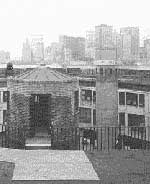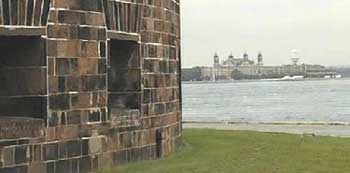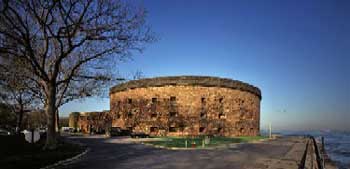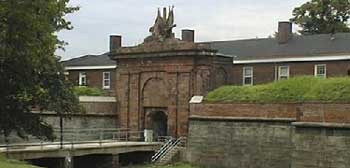





Survey of Historic Sites and Buildings
  |
GOVERNORS ISLAND NATIONAL MONUMENT (including Castle Williams and Fort Jay New York |
 Governors Island National Monument |
| ||
For more than two centuries, Governors Island, a half mile from the southern tip of Manhattan in New York harbor, has been a mystery to most observers, or — perhaps more typically — just overlooked by the commanding vista dominated by the neighboring Statue of Liberty and Ellis Island. From 1776 to 1996, the military installations on the island protected the United States, and the ideals the statue across the harbor represents.
Governors Island is a 172-acre island whose name dates back to the 1780's when New York was a British colony and the colonial assembly reserved the island for the exclusive use of New York's royal governors.
During the begining of the American Revolution in 1776, General George Washington had the island fortified with earthworks just prior to the Battle of Long Island (also known as the Battle of Brooklyn) - the first ever engagement of the fledgling American Army with British forces, and the largest battle of the entire war. The island's artillery covered the retreat of the American Army, preventing an untimely end to the revolution, but at the cost of losing New York City to British occupation for almost eight years, the remainder of the conflict.
 |
| Governors Island National Monument. |
With American independence from Britain in 1783, New York and the nation were determined to prevent any future occupation of the city and its strategic waterways by an enemy power. Towards that end, three fortifications were placed on Governors Island in the years preceding the War of 1812 as part of an extensive coastal defense system. The first, Fort Jay, is a square five bastioned fort started in the 1790's on the site of the earlier earthworks. The second, Castle Williams, a circular casemated work was completed in 1811. A third, South Battery, guarded the Buttermilk Channel of the harbor. The first two forts are among the best remaining examples of First System (Fort Jay) and Second System (Castle Williams) of American coastal fortifications.
During the Civil War, Castle Williams held Confederate prisoners of war and Fort Jay held captured Confederate officers. After the war, Castle Williams was used alternately as a recruit barracks and military stockade, becoming the east coast counterpart to military prisons at Fort Leavenworth, Kansas and Alcatraz Island, California.
In 1878 the military installation on the island, then known collectively as Fort Columbus, became a major Army headquarters center and, in 1933, the home of the United States First Army. When the Army left Governors Island in 1966, the installation became a U.S. Coast Guard base - the largest in the world. The closing of the base in 1996 concluded almost two centuries of the island's use as a federal reservation devoted to the protection of New York and the nation.
In 2001, the historic fortifications of Fort Jay and Castle Williams became a national monument. On January 31, 2003, the Governors Island National Monument was transferred to the U.S. Department of the Interior and is now managed by the National Park Service.
As a new national monument, Governors Island is not fully operational and is open only on a seasonal basis at this time, so services and facilities are extremely limited.
 |
| Castle Williams. |
Castle Williams
This circular stone fortification, designed and built during the years 1807-11 by Lt. Col. Jonathan Williams on the northwestern tip of Governors Island, served as a twin fort with Castle Clinton in guarding the channel between Governors Island and New York City. Known as the "Tower" during construction, in 1810 Castle Williams received its present name. Though never threatened, it has served throughout the years in the defense of New York. Repaired in 1833 and 1836, it served as a prison during the Civil War. Its foundation sits on a rock surface. Its red sandstone walls are 40 feet high and have an 8-foot-thick base and a 7-foot top. The stones in the outer walls are dovetailed. A double row of bombproof arches in the walls once contained two tiers of heavy cannon. The interior of the fort contained two brick buildings and a well; these were removed in 1912 when the fortification was converted into a military prison. In good condition today, Castle Williams may be visited each spring on Armed Forces Day. At other times, visiting arrangements may be made with the Information Officer at Fort Jay.
 |
| Fort Jay. |
Fort Jay
Fort Jay, begun by the city of New York late in the 18th century, was the earliest permanent fortification on Governors Island and remains an active military post today. It has never been attacked. Because of the threat of war with France in the early 1790's, the city of New York sought to strengthen existing harbor defenses and build others. In 1794 Congress appropriated money to the city for construction of a fort on Governors Island. Construction began that year, and additional appropriations in following years made possible completion of the fort by 1798. It was named Fort Jay, in honor of John Jay, Secretary for Foreign Affairs. In 1800 the city ceded the island to the United States, which in 1806 razed most of the fort and rebuilt it. Completed in 1808, it consisted of an enclosed pentagonal structure, having 4 bastions capable of mounting 100 guns. On its completion, officials renamed it Fort Columbus, but in 1904 the Secretary of War restored the original name.
The Army repaired the fort in 1833 and in 1836; it remains today much as it was then. It is open to the public each spring on Armed Forces Day. At other times, visits may be arranged with the Information Officer at Fort Jay.
NHL Designation: 02/04/85 (Governors Island)
 |
 |
http://www.cr.nps.gov/history/online_books/founders-frontiersmen/sitea22.htm
Last Updated: 29-Aug-2005